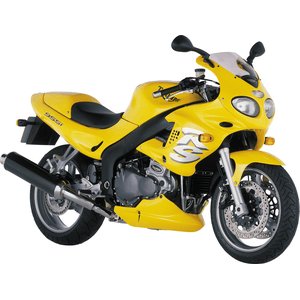Triumph Sprint RS 955 (2002-2004): A Sport Tourer with a Rebellious Streak
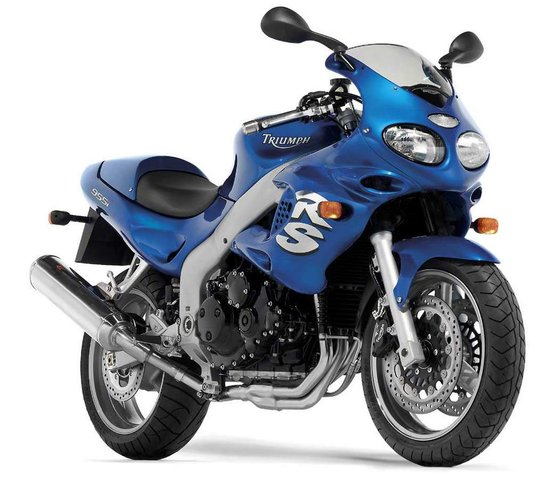
Introduction
The Triumph Sprint RS 955 occupies a unique space in motorcycling history—a sport-touring machine that refuses to compromise on adrenaline. Produced between 2002 and 2004, this British icon bridges the gap between weekend canyon carving and cross-country comfort. With its snarling 955cc inline-three engine, aggressive half-fairing, and chassis tuned for agility, the Sprint RS feels like a wolf in sheep’s clothing.
Having spent time with a well-preserved 2003 model, it’s clear why this bike developed a cult following. It’s not the fastest, lightest, or most technologically advanced machine of its era, but it delivers something far more compelling: character. From the moment you thumb the starter and hear the triple’s guttural idle, the Sprint RS announces itself as a bike that prioritizes feel over frills. Let’s dive into what makes this generation a standout.
Design & Styling
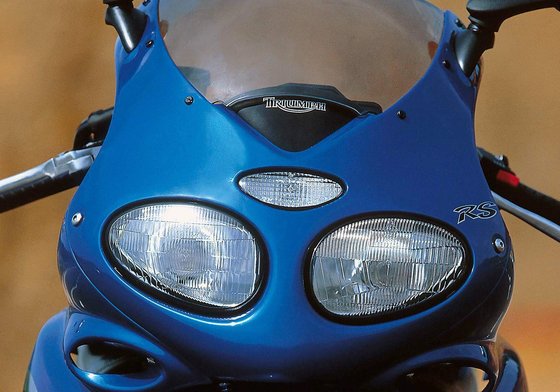
The Sprint RS’s design philosophy is best described as “purposeful minimalism.” Unlike its fully faired sibling, the Sprint ST, the RS opts for a half-fairing that exposes the engine’s muscular lines. The result is a machine that looks lean and athletic, with a narrow profile accentuated by its 735mm (28.9-inch) handlebars.
Triumph’s choice of a double-sided swingarm—a deliberate cost-saving measure over the ST’s single-sided unit—adds a touch of industrial honesty to the design. While some might miss the flashier alternative, the exposed chain and sprocket (19/43 tooth ratio) give the RS a raw, mechanical aesthetic. The Aston Green paint option, a hallmark of early-2000s Triumphs, still turns heads with its deep metallic finish.
The cockpit is Spartan but functional. A white-faced analog tachometer dominates the dash, flanked by a small LCD screen for speed, odometer, and trip data. It’s a refreshingly simple setup compared to modern TFT displays, though the LCD’s visibility suffers in direct sunlight.
Ergonomically, the RS strikes a thoughtful balance. The 805mm (31.7-inch) seat height accommodates shorter riders without feeling cramped, while the slightly forward-leaning riding position keeps wrists lightly loaded. Two-hour rides revealed no numb butt syndrome, thanks to a well-padded seat that’s broader than most sport bikes of the era.
Engine & Performance
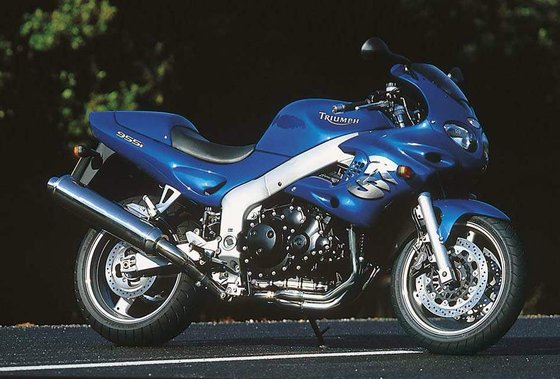
At the heart of the Sprint RS lies Triumph’s legendary 955cc inline-three—a powerplant that’s equal parts refined and rowdy. With 120 HP (87.5 kW) at 9,100 RPM and 100 Nm (73.8 lb-ft) of torque peaking at 5,100 RPM, this engine doesn’t dominate spec sheets. But specs lie.
Twist the throttle, and the triple’s personality emerges. From 1,900 RPM in sixth gear, the RS pulls cleanly, building to a ferocious top-end crescendo. The real magic lives between 4,000–8,000 RPM, where torque arrives in a seamless wave. Unlike peaky four-cylinders, this motor encourages you to short-shift and surf the midrange—a trait that makes it devastatingly effective on twisty backroads.
Triumph’s Sagem fuel injection deserves special praise. For an early-2000s system, its throttle response is remarkably linear. There’s none of the low-speed jerkiness that plagued contemporaries like Yamaha’s TT600. In stop-and-go traffic, the RS behaves like a commuter bike, but crack the throttle open, and the exhaust note transforms from a purr to a chainsaw snarl.
The six-speed transmission is mostly slick, though our test bike exhibited occasional false neutrals when rushing upshifts. Deliberate footwork solved the issue, and the cable-actuated clutch remained light even during aggressive riding.
Handling & Dynamics
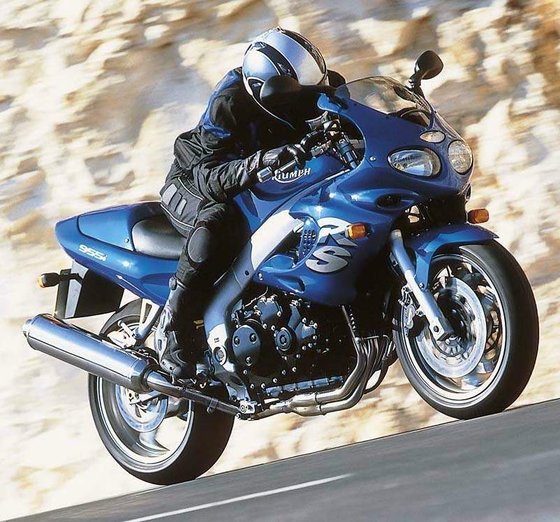
Weighing 199 kg (438 lbs) dry, the Sprint RS isn’t a featherweight. But once moving, it defies physics. The aluminum twin-spar frame and 24.5-degree rake combine for razor-sharp turn-in, while the 1470mm (57.9-inch) wheelbase ensures stability at speed.
Dual-rate front forks (43mm diameter, preload-adjustable) handle small bumps with surprising suppleness, though larger impacts send a jolt through the bars. Out back, the preload- and rebound-damping-adjustable monoshock stays composed during hard cornering. Push too hard over broken pavement, and the front end gets chatty—a reminder that this is a 20-year-old design.
Braking performance remains a highlight. Twin 320mm front discs gripped by Nissin four-piston calipers deliver fierce stopping power, with lever feel that’s progressively firm. The rear 255mm disc is predictably vague, but that’s par for the course in this segment.
Competition
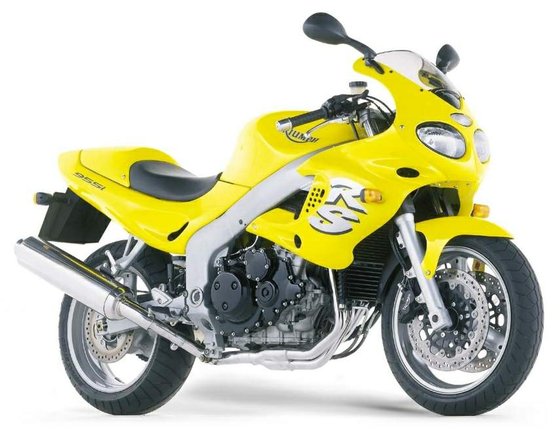
In the early 2000s sport-touring arena, the Sprint RS faced formidable rivals:
-
Honda VFR800 Interceptor
Honda’s V4 gem offered smoother power delivery and legendary reliability but weighed 213 kg (470 lbs). The RS’s 14 kg (31 lbs) weight advantage and taller gearing made it the livelier backroad companion. -
Yamaha FJR1300
Yamaha’s liter-class tourer prioritized comfort with a plush seat and upright ergonomics. However, its 1448cc inline-four felt sterile compared to the Triumph’s charismatic triple. -
Ducati ST4
The Italian alternative brought desmo valve drama and 916-derived styling. While the Ducati’s 996cc V-twin outpowered the RS (105 HP vs. 120 HP), its maintenance costs and cramped ergonomics narrowed its appeal.
The Sprint RS carved its niche by blending sport bike reflexes with real-world usability. It’s less polished than the Honda, less exotic than the Ducati, but more engaging than either.
Maintenance
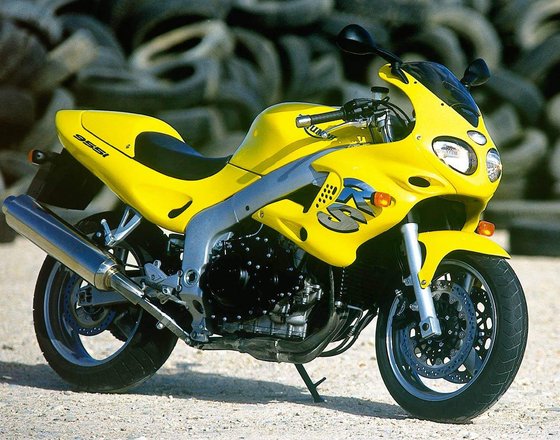
Owning a 20-year-old Triumph requires diligence, but the Sprint RS is relatively straightforward to maintain:
- Valve Adjustments: Every 12,000 km (7,500 miles). Intake valves: 0.10–0.20mm (0.004–0.008"), exhaust: 0.20–0.30mm (0.008–0.012"). Consider upgrading to shim kits from MOTOPARTS.store for precise adjustments.
- Oil Changes: Use synthetic 10W-40 or 15W-50. Capacity: 3.2L (3.4 quarts) with filter.
- Cooling System: Flush every 2 years with ethylene glycol-based coolant (2.8L capacity).
- Chain Care: The 108-link chain demands regular lubrication. Our X-Ring Chain Kit reduces maintenance frequency.
- Tire Pressures: 2.2 bar (32 psi) front / 2.6 bar (38 psi) rear.
Common upgrades include aftermarket exhausts (to unlock the triple’s full voice) and progressive fork springs for improved damping.
Conclusion
The Triumph Sprint RS 955 is a time capsule of early-2000s motorcycling—a era when electronics didn’t mediate the ride and engines had personalities. It’s not perfect: the suspension shows its age, and the transmission requires mechanical sympathy. But these quirks only deepen the bond between rider and machine.
For owners looking to refresh their RS, MOTOPARTS.store offers everything from OEM-spec NGK CR9EK spark plugs to premium brake pads. Whether you’re chasing knee-down thrills or a nostalgic Sunday ride, this Triumph reminds us that the best bikes aren’t just ridden—they’re felt.
Specifications sheet
| Engine | |
|---|---|
| Stroke: | Four-stroke |
| Max power: | 88 kW | 118.0 hp |
| Max torque: | 100 Nm |
| Fuel system: | Multipoint sequential electronic fuel injection |
| Lubrication: | Wet sump |
| Max power @: | 9100 rpm |
| Displacement: | 955 ccm |
| Max torque @: | 5100 rpm |
| Bore x stroke: | 79.0 x 65.0 mm (3.1 x 2.6 in) |
| Configuration: | Inline |
| Cooling system: | Liquid |
| Compression ratio: | 12.0:1 |
| Number of cylinders: | 3 |
| Dimensions | |
|---|---|
| Wheelbase: | 1470 mm (57.9 in) |
| Dry weight: | 199 |
| Wet weight: | 220 |
| Seat height: | 805 mm (31.7 in) |
| Overall width: | 735 mm (28.9 in) |
| Overall height: | 1170 mm (46.1 in) |
| Overall length: | 2120 mm (83.5 in) |
| Fuel tank capacity: | 19.5 L (5.15 US gal) |
| Drivetrain | |
|---|---|
| Final drive: | chain |
| Chain length: | 108 |
| Transmission: | 6-speed |
| Rear sprocket: | 43 |
| Front sprocket: | 19 |
| Maintenance | |
|---|---|
| Engine oil: | 10W40 |
| Brake fluid: | DOT 4 |
| Spark plugs: | NGK CR9EK |
| Spark plug gap: | 0.6 |
| Coolant capacity: | 2.8 |
| Forks oil capacity: | 0.918 |
| Engine oil capacity: | 3.2 |
| Valve clearance (intake, cold): | 0.10–0.20 mm |
| Valve clearance (exhaust, cold): | 0.20–0.30 mm |
| Recommended tire pressure (rear): | 2.6 bar (38 psi) |
| Recommended tire pressure (front): | 2.2 bar (32 psi) |
| Chassis and Suspension | |
|---|---|
| Rake: | 24.5° |
| Frame: | Aluminium twin-spar |
| Trail: | 80 mm (3.1 in) |
| Rear tire: | 180/55-17 |
| Front tire: | 120/70-17 |
| Rear brakes: | Single 255 mm disc, 2-piston caliper |
| Front brakes: | 2 x 320 mm discs, 4-piston calipers |
| Rear suspension: | Monoshock, adjustable preload, compression, and rebound damping |
| Front suspension: | 45 mm telescopic forks, dual-rate springs, adjustable preload |



